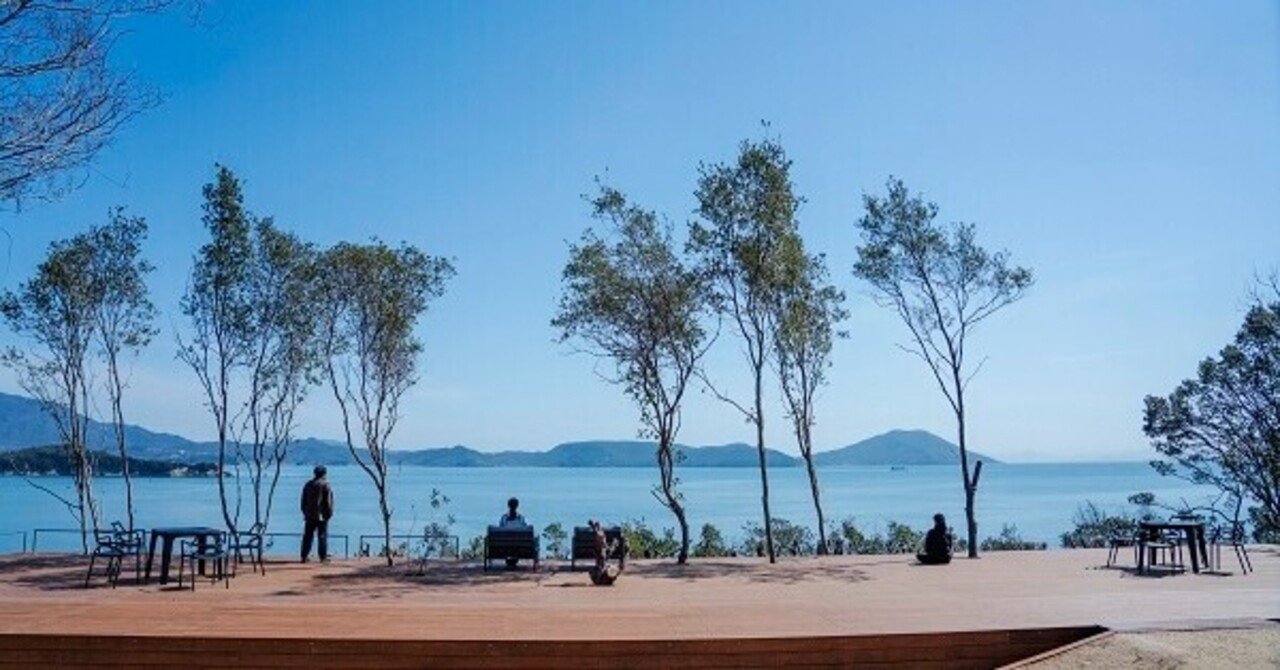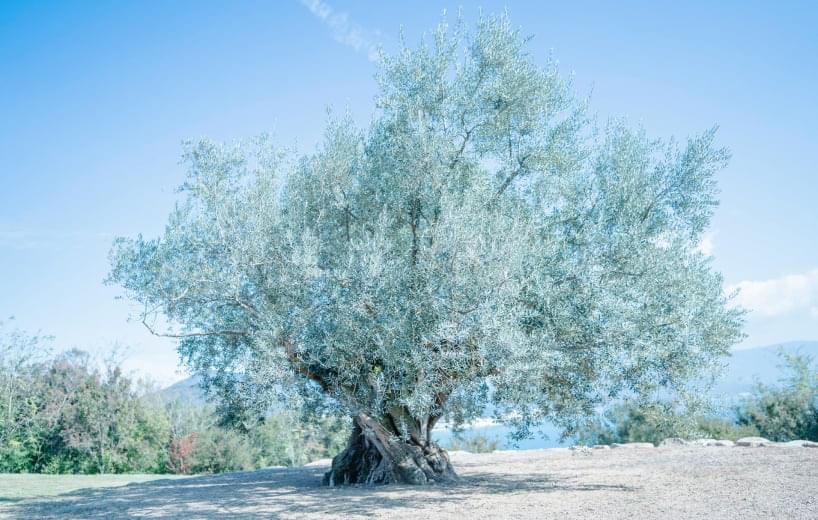
Feb
13.2021


Take in the Olive Trees of Shodoshima’s Ocean Terrace
If you sit beneath the boughs of that tree, you can watch the black birds dance in the sky and listen to the songs of the pheasants and doves.
The thick branches of this huge tree, which was born in Spain, have been protecting its trunk from the blazing sun for 1,000 years. It came to Shodoshima 10 years ago, and since then it has adjusted to the island’s sun, wind, water, and soil, absorbing enough nutrients to produce 100 kilograms of fruit every year. What kind of landscape does this tree see every day?
We want our guests to enjoy the olives as well as have an appreciation for the abundance of life that is in the essense of this tree. That’s why we’ve created this terrace--so that you can experience nature as you sit below it and enjoy the view of the ocean. Here on this terrace, you can enjoy a Plant Meditation as you sit gazing upon the gently rolling Seto Inland Sea. Perhaps it will help you open your eyes to a new revelation.







The Thousand-Year Tree originally hails from the region of Andalusia in Spain, which has a typical Mediterranean climate: arid, with little rain and plenty of sunlight. It’s also the region where 80 percent of Spanish olive oil is produced. Fossils of olives unearthed from the ground serve as evidence that the region has thousands of years of history, which still continues to this day. This particular tree, which was transplanted through the efforts of the extraordinary horticulturist and plant hunter Seijun Nishihata, was originally eight meters tall, though in order to fit in the container it traveled in, had to be cut down by three meters. Even so, it still weighs about three tons. Using special technology, this tree was carried about 10,000 kilometers across the ocean from Spain to Shodoshima over the course of one month.

In the very distant past, the Seto Inland Sea was once dry land. One day water filled the space, turning it into a sea and the pockets of land into little islands. As such, the islands you see before you, which number more than 700, were once part of the land. You might find traces of that land in the sandbars that appear between the islands during low tide, making a path dubbed the “Angel Road”.
Surrender yourself to the view of the ocean here as you gaze upon the slowly ebbing waters and, occasionally, the sky. Around you the birds will sing, the ocean wind will blow in to rustle the trees, and you might even be able to hear the joy of the plants as they soak in the sunlight.
As you sit on this terrace, try to feel the vitality of the natural world around you. To help you learn from nature, we have prepared a meditation program for you called “Plants Meditation”, based on the wisdom of plants.



Humans can learn much from the wisdom of plants. Each and every plant has something to teach us. For example, the willow tree can teach us about flexibility, the silk tree can teach us about turning off, and the olive tree can teach us about lightheartedness. Once you’ve studied the wisdom of plants, why not strive to instill it within yourself through the Plant Wisdom program created by Toryo Ito, Buddhist high priest of Ryosoku-in Temple? Then, as you walk around town and see the plants featured in the program, perhaps you can remember their wisdom. At The Terrace of Shodoshima’s Olive Forest, we’ve also prepared two meditation programs so that you can instill the wisdom of the olive tree within yourself.
01
There are many plants that can be harvested for oils, but the olive is unique in that its oil comes not from its seeds but from its flesh. The olive itself is made of 10 percent oil, which can be squeezed out without applying any heat, so the oil produced is extremely fresh. That’s what makes olives so precious to us. But though olive trees produce plenty of flowers, only about 3 percent of the flowers produce fruit, so you have to approach olive farming with a certain lightheartedness, knowing that a tree will not yield much. Still, the trees’ roots are relatively shallow, which helps them grow all over the world, and that special feature allowed a 1,000-year-old tree to be transferred from Europe to Japan. That’s why it’s often characterized as a very adaptable tree.
In Zen, lightheartedness is an important concept. It’s easy to make your heart heavy or to feel down, but it’s much harder to lighten it. Here, let us instill the lightheartedness of the olive tree within ourselves with a meditation on this plant’s wisdom.
02
The olive tree is especially beautiful for its leaves, which are dark green on one side and silver on the other. Because they maintain their leaves all year round, they’re beloved around the world as decorative and ornamental trees. The underside of the leaves are adorned with what looks like a fuzz, which is what gives them that silver color. Under a magnifying glass, these little hairs actually look like chrysanthemum flowers, or even scales, which are closely packed together. These are meant to catch and contain water, which is especially useful in dry climates. What kind of severe environments has this tree endured in order to gain this wisdom?
And what about the other side of yourself? There may be many people who ignore or even take for granted the inner parts of ourselves that we never show to others. Let’s meditate on the olive tree’s ability to “Appreciating Our Inner Selves” and instill it within ourselves.


01
When the page loads, insert the 6-letter password, which you can find at The Terrace, and a new page will load.

02
Choose either the Lightheartedness program or the Appreciating Our Inner Selves program to start with, and listen to the audio.

03
Sit in a comfortable position facing the ocean, and experience the Plant Meditation.

04
When your meditation is over, take some time to observe the nature around you.


InTrip is a genuine Zen and meditation app for balancing your mind and body, made by Toryo Ito of Ryosoku-in Temple, which is a Zen temple often visited by business leaders. How can you incorporate Zen into your daily life? Can it be useful to the modern businessman or woman? InTrip offers various Zen programs that will show you the benefits of Zen.

The director of this Plant Meditation is Buddhist High Priest of Ryosoku-in Temple, Toryo Ito, who is also Managing Director Priest of the mind-restoring app InTrip. He has also supervised 是是XEXE, a program in pursuit of beauty and wisdom cultivated through Zen. He’s currently in the process of creating a temple that is more like a settlement, which aims to redefine “quality” through reconstructing the ideas of fields, food, gardens, saunas, self-care, residences, burials, and cycles.






InTrip is a genuine Zen and meditation app for balancing your mind and body, made by Toryo Ito of Ryosoku-in Temple, which is a Zen temple often visited by business leaders. How can you incorporate Zen into your daily life? Can it be useful to the modern businessman or woman? InTrip offers various Zen programs that will show you the benefits of Zen.

For 300 years, Shodoshima Healthy Land has been working to build the Olive Forest with the hopes of helping travelers achieve healthy bodies and minds. The huge, thousand-year-old olive tree stands as a symbol of their initiative. Starting from tilling the soil and nurturing the trees until they are blessed with olives, they’re dedicated to researching the various possibilities of olive trees. They use all parts of the tree to create useful products for beauty and health, leaving no leaf or branch to waste.